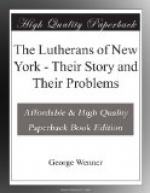Those were famous battles which were fought in the sixteenth and seventeenth centuries in defence of the Lutheran position. Our Church had to contend with two vigorous foes in the statement of her doctrines, Rome and Reform. The antinomian and synergistic controversies, Osiander, Major and Flacius, the Philippists and the Crypto-Calvinists are names that still remind us of the theological carnage of the sixteenth century.
In the seventeenth century came the reign of the dogmaticians. The eighteenth century was the age of Pietism and this was followed by Rationalism. The scope of this Introduction does not require us to explain the significance of these movements. Students of Church History are familiar with them.
The revival of spiritual life at the beginning of the nineteenth century brought with it also a revival of church consciousness and a restoration of the confession of the church. Both in Europe and in America the attempt has been made to secure the unity of the church on the basis of subscription to the various Symbols included in the Book of Concord. These Symbols, besides the Ecumenical Creeds and the Augsburg Confession, are Melanchthon’s Apology, that is Defence of the Augsburg Confession, Luther’s two Catechisms, the Smalcald Articles and the Formula of Concord. The later Confessions supplement and explain the statements of the Augsburg Confession. As such they are valuable exponents of Lutheran teaching. Many of our churches in Europe as well as in America require of their ministers subscription to these Confessions. At the same time it is also true that many churches, whose Lutheranism cannot be impugned, find in the Augsburg Confession an adequate expression of their doctrinal position.
According to the Confessors of Augsburg: “For the true unity of the church it is sufficient to agree concerning the doctrines of the Gospel.”
It would seem, therefore, to be in harmony with the spirit of Lutheranism to make “the confession of the churches” rather than “the Confessions of the Church” the bond of union. Underneath the Confessions there are distinctive principles differentiating us from the sacerdotal churches on the one hand and from the Reformed churches on the other hand.
The soul of the Confessions is the confession, and this soul we may recognize amid all the changes that take place in the course of time and the progress of thought. It reveals itself in innumerable forms, in sermons and in sacred song, and above all in the sanctified lives of those who confess the faith.
In conversation with an eminent teacher in one of our most conservative schools, the author not long ago requested a definition of Lutheranism from the standpoint of the school which the Professor represented. Of course, it was suggested, the acceptance of the Symbolical books must be presumed, sine qua non.
The reply was: “The Symbolical Books are valuable, but their obligatory acceptance is not essential: The same is true even of the Augsburg Confession. Any one who accepts the teachings of Luther’s Small Catechism is a Lutheran. The heart of the Lutheran faith may be expressed in the following words: “Man is a sinner who can be saved by grace alone.”




